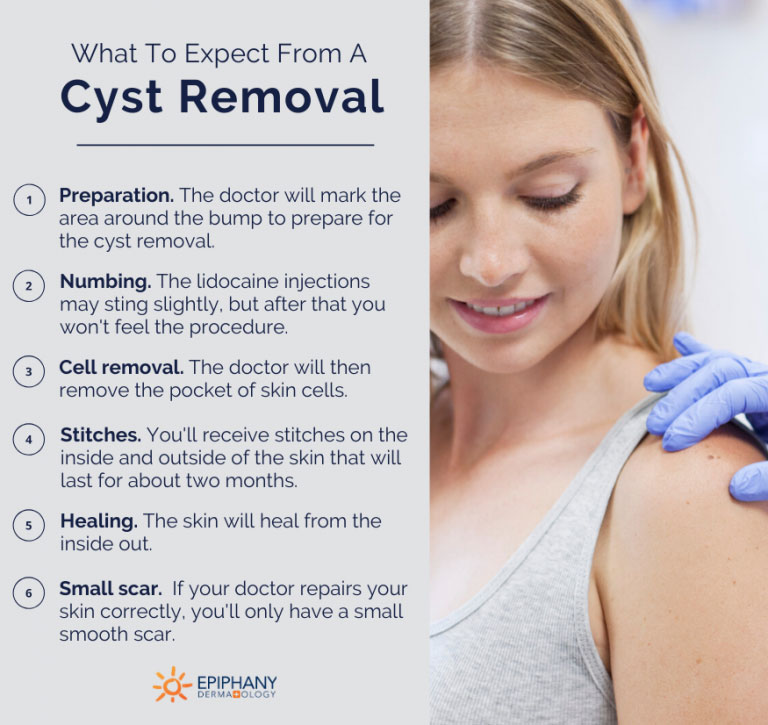Have you ever noticed a little bump under your skin that feels like a ball? Maybe it’s been there a while, but now a stinging pain accompanies it. Or maybe there’s no pain at all, but the bump won’t seem to go away.
Pain or not, you’re probably dealing with a cyst. And your best bet is to visit the dermatologist immediately for a cyst removal.
What Is a Cyst?
A cyst is a sac that forms in the body — it can form in bones, organs, or tissues. The cysts that form in the skin are essentially a pocket that is filled with skin cells, bacteria, and/or pus. They vary dramatically in size and can be found anywhere on the body. As time goes by, more and more skin cells are trapped in the cyst causing the cyst to grow larger.
What Are the Symptoms of a Cyst?
A cyst feels like a little knot or kernel underneath the skin. It may begin as an ingrown hair or acne pore that becomes infected, creating an opportunity for the skin to get turned in on itself. A cyst feels like a bump or a knot in the skin. The cyst may become large enough to drain the rotten skin cells, these cells cause the putrid smell.
What Causes Skin Cysts?
A cyst happens when the skin turns in on itself. Think of the skin like a flat balloon. If the balloon has something inside (like skin cells) to push out, it naturally pushes it out through the opening. But if something plugs that opening, the cells are trapped inside the balloon. The balloon becomes a pocket for these cells that can’t leave.
Types of Cysts
Although there are many types of cysts, there are three common types of cysts in the skin, Pilar Cysts, Sebaceous Cysts, and Digital Mucous Cysts, and each have different characteristics. Different types of cysts occur in different parts of the body for different reasons, so it’s important to have a general understanding of cysts and, if you notice one developing, have it checked by a specialist.
What Type of Doctors Treat Cysts?
While most primary care doctors or surgeons can treat cysts on the skin, dermatologists most commonly treat and remove sebaceous and pilar cysts. Dermatologists are focused on treating the skin — so removing cysts is a natural part of their training and focus.
How Can a Dermatologist Remove a Cyst?
Both of these types of cysts can be removed using out-patient procedures. Dermatologists usually opt for lancing a cyst if it has ruptured. If the cyst is still intact, they typically excise it.
Lancing a Cyst
Lancing a cyst involves using a sharp knife to create a hole in the cyst. The doctor then squeezes and drains the contents. This is what you may see on YouTube cyst-popping videos. But, lancing a cyst isn’t typically the best way to get rid of the cysts permanently. However, if a cyst has already ruptured, this procedure allows us to remove most of the contents. In these cases, it’s important to remove the sack around the contents. If the lining of the cyst wall is not removed, the cyst will eventually reform.
Excising a Cyst
When a cyst is intact, an excision is typically the best removal procedure. We make an elliptical incision around the cyst to take out the entire cyst wall and contents. We stitch it up on the inside and outside and let it heal.
The YouTube Way vs. The Dermatologist Cyst Removal
If you’ve seen the way some doctors on YouTube pop pimples, don’t be fooled. That’s not the best way to deal with your cysts. Don’t punch and squeeze them — the right way is to completely remove the sac, like Epiphany’s Chief Medical Officer, Dr. R. Todd Plott, does in the video below. If you leave the sac in the skin, the cyst will likely come back.
Should You Remove Cysts at Home?
At-home cyst removals do not work. There are plenty of YouTube videos showing home remedies for treating cysts. Do NOT try them. When people mash and lance their cysts, trying to squeeze out the inside, the cysts will just come back.
Remember, a cyst is a pocket in your skin lined with cells. The skin will continue to produce cells and refill the pocket as long as the pocket is there. You’re not treating the problem by squeezing the cyst. The pocket has to be removed.
If you try these DIY cyst-removal strategies, you can make the problem worse. By popping the cyst, you open the sac and make it more susceptible to infection. Plus, you’ve now damaged the skin and increased the likelihood of scarring.
The best way to treat a cyst at home is to keep it clean. Make sure you’re washing it with soap and water. If you want it removed, visit the dermatologist to have it removed professionally.
What To Expect From Cyst Removal
During a cyst removal, the doctor will mark and numb the area around the bump. You’ll get a few Lidocaine injections that may slightly sting, but that’s the worst part. After that, you won’t feel the procedure.
The dermatologist will then remove the pocket of skin cells, and put stitches on the inside and outside of the skin that will last for about two months. The skin will heal from the inside out.
If your doctor repairs your skin correctly, you’ll only have a small, smooth scar.
Make sure your doctor stitches the inside of the pocket or you may be left with a hollow place in your skin where the gap was not closed correctly. A dermatologist is trained to repair skin in a way that will get the skin back to normal. There’s no home remedy that can do that.
Does a Cyst Removal Hurt?
If you can handle the small sting of a shot, you can handle a cyst removal. The doctor first topically numbs the cyst area and then injects Lidocaine. You may feel a slight sting, but that’s the worst part.
How Long Does a Cyst Removal Take?
A cyst removal is a relatively simple procedure. It should take no longer than 30 minutes to remove most cysts.

What To Expect After a Cyst Removal
Your post-treatment options depend on what type of cyst removal your doctor used.
After lancing a cyst, the wound needs to be left open for healing. It will continue to drain after the procedure. Then, it will begin to heal from the inside out. In these cases, watch for the cyst to reform. There’s a higher risk the cyst might come back if the doctor was not able to completely remove the cyst wall.
If you had a cyst excised, you’ll have stitches inside and outside to minimize scarring. Patients may experience tenderness and mild pain after an excision, easily managed with at-home pain medication such as Advil.
Does Insurance Cover Cyst Removal?
Insurance usually covers cyst removals. Since a cyst removal is a medical procedure (not cosmetic), the costs go against your deductible. Exact cyst removal costs depend on your insurance and whether you’ve met your deductible. Remember, you’ll have to pay out-of-pocket if you haven’t met your deductible, but cyst removal costs usually count towards that amount.
What if a Cyst Pops on Its Own?
While people can try to squeeze and drain a cyst that pops on its own, it can be very painful and ineffective. It’s best to seek care from a physician. The doctor will have a better chance of completely removing all the contents from the cyst so that it better heals and has a lower chance of recurrence. They will also be able to provide numbing medication to minimize pain during the lancing procedure.
How to Know if You Have a Cyst
If you feel something hard under your skin, get it checked out as soon as possible. It may be a normal cyst that the doctor can easily remove, but it could also be something different.
Find an Epiphany provider near you to schedule a cyst removal.

Dr. R. Todd Plott is a board-certified dermatologist in Coppell, Keller, and Saginaw, TX. His specialization and professional interests include treating patients suffering with acne, identifying and solving complex skin conditions such as psoriasis, rosacea, atopic dermatitis, and identifying and treating all types of skin cancers. In his spare time, Dr. Plott enjoys cycling, traveling with his wife, and spending time with his children and new grandson.
Learn more about Dr. Plott.


